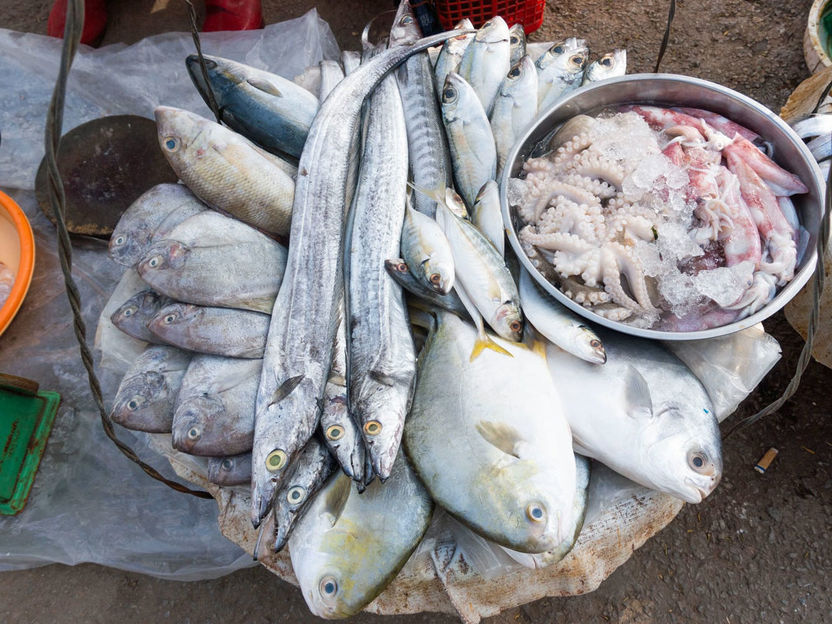Toxic arsenic in the brain and in breast milk
Research group investigated certain arsenic compounds that were previously considered harmless
Advertisement
arsenic is probably the most popular of all poisons and the subject of countless detective stories. What is less well known is that it is found in drinking water, fish and rice. In its pure form or in inorganic chemical compounds without carbon it disturbs the energy balance of the cell and can even trigger cancer. Organic compounds found in food, on the other hand, were previously considered harmless, although there was a lack of reliable studies on the subject. The Graz-based chemist Kevin Francesconi and his research group have now attempted to fill this gap in an international project partly funded by the Austrian Science Fund FWF.

Only recently researchers realised that fish and crustaceans contain large amounts of organic arsenic in toxic form. This may have effects on humans.
Daniel Lee/unsplash
Arsenic in fish
“We have had quite a good level of knowledge of inorganic arsenic compounds that are found in food and drinking water all over the world, for the last 30 or 40 years. We know that these compounds are highly toxic and can cause heart disease or cancer,” explains principal investigator Francesconi. “But it was only recently that we realised that marine life such as fish and crustaceans also contain large amounts of arsenic in toxic form,” he notes.
Arsenic in our water and food – is our planet really polluted to such an alarming extent? “No, the arsenic is mostly of natural origin,” says Francesconi. It is dissolved in seawater and algae mistake it for phosphate and absorb it. Via the algae, it is taken up by other marine organisms, which have therefore developed strategies to incorporate the arsenic into their organisms in a non-toxic form.
Non-toxic arsenic
Going by the name of arsenobetaine, this compound is produced by an atom of the metal arsenic being incorporated into the body’s own betaine molecule instead of a nitrogen atom. Arsenobetaine has been known for a long time to be harmless, which conveyed a sense of security that now turns out to be deceptive: “Research on arsenic in marine organisms was not pursued further. Only recently, we were able to show through our work in Graz that there are a whole range of other arsenic compounds found in marine life that are indeed very toxic,” says Francesconi.
He is talking about molecules in which arsenic is bound to lipids, which are part of the body’s fat metabolism. One of the dangers presented by these arsenic compounds is the fact that they are fat-soluble and can therefore easily penetrate cell walls. In the present basic-research project, Francesconi’s team in Graz has now investigated these arsenic compounds together with a working group from the University of Potsdam. It was shown that, unlike arsenobetaine, these compounds can be highly toxic.
Fruitful cooperation
“In Graz we specialise in analytical work,” notes Francesconi. “We develop methods to detect these components, and we also have the possibility to produce the compounds in pure form – a particularly valuable prerequisite for toxicological studies,” he points out. Accordingly, Francesconi and his team analysed water and food samples and produced the arsenic compounds they found there in pure form. These compounds were then sent to the partner institute in Germany, which specialises in toxicological studies. “This was an enormously fruitful collaboration,” says Francesconi. In Potsdam, tests were carried out on human cells, and subsequently on fruit flies, nematodes and mice.
Tissue samples were sent to Graz for analysis to learn how the arsenic behaved in the body. One of the things shown in the process was that in mice arsenolipid gets past the blood-brain barrier and accumulates in the brain. Based on these data, further joint projects were established, inter alia with Norwegian and Japanese partner institutions. Both of these countries are known for their high consumption of fish and seafood. Together with the Norwegian research partners, the scientists were ultimately able to show that the arsenic compounds are passed on to children via human breast milk.
The danger is difficult to assess
Despite the numerous results, it is not possible at this point to say exactly how much danger the compounds present for humans. “We know that the effects in humans can be completely different from those in animal experiments,” notes Francesconi. Accordingly, he emphasises that there is still a lot of work ahead: when the European Union set limits for arsenic in certain foodstuffs in 2016, organic arsenic compounds and the entire area of fish and seafood were deliberately excluded; the reason given was that not enough data was available at that point in time.
The results of the project are an important first step, says Francesconi, but: “Large epidemiological studies are now needed to know exactly how dangerous these substances really are.” This requires large laboratories equipped with the analytical methods developed by Francesconi and his team. A major part of the project funds had gone into the development of these methods. For this reason, such studies are not only costly, but also require an enormous investment of time. The project, which was part of a DACH project for cooperation between Germany, Austria and Switzerland, ran for three years and ended in 2019.
Original publication
Xiong, Ch., Stiboller, M., Glabonjat, RA., Rieger, J., Paton, L., Francesconi, KA.; "Transport of arsenolipids to the milk of a nursing mother after consuming salmon fish", Journal of Trace Elements in Medicine and Biology; Vol. 61, 2020.
Yu, X., Xiong, Ch., Jensen, KB., Glabonjat, RA., Stiboller, M., Raber, G., Francesconi, KA.; "Mono-acyl arsenosugar phospholipids in the edible brown alga Kombu (Saccharina japonica)"; Food Chemistry; Vol. 240, 2018.
Witt, B., Meyer, S., Ebert, F., Francesconi, KA., Schwerdtle, T.; "Toxicity of two classes of arsenolipids and their water-soluble metabolites in human differentiated neurons"; Archives of Toxicology; 2017.



























































